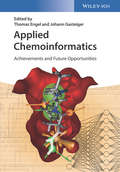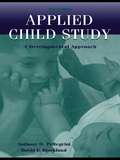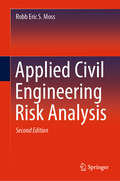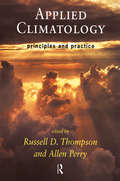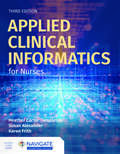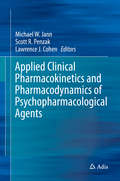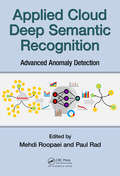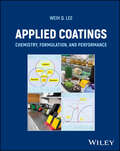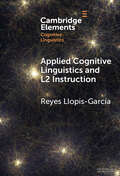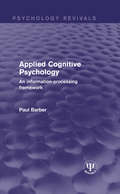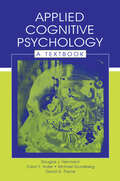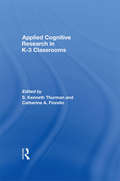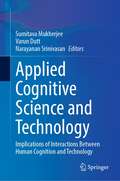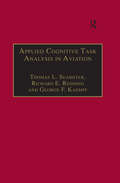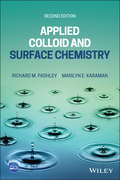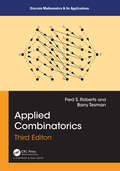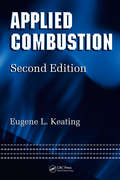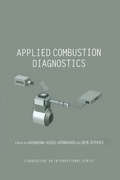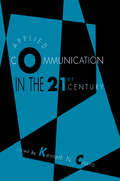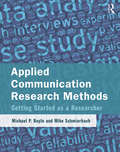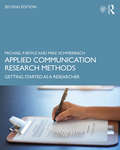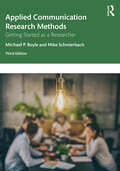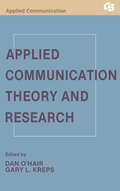- Table View
- List View
Applied Chemoinformatics: Achievements and Future Opportunities
by Thomas Engel Johann GasteigerEdited by world-famous pioneers in chemoinformatics, this is a clearly structured and applications-oriented approach to the topic, providing up-to-date and focused information on the wide range of applications in this exciting field.The authors explain methods and software tools, such that the reader will not only learn the basics but also how to use the different software packages available. Experts describe applications in such different fields as structure-spectra correlations, virtual screening, prediction of active sites, library design, the prediction of the properties of chemicals, the development of new cosmetics products, quality control in food, the design of new materials with improved properties, toxicity modeling, assessment of the risk of chemicals, and the control of chemical processes.The book is aimed at advanced students as well as lectures but also at scientists that want to learn how chemoinformatics could assist them in solving their daily scientific tasks.Together with the corresponding textbook Chemoinformatics - Basic Concepts and Methods (ISBN 9783527331093) on the fundamentals of chemoinformatics readers will have a comprehensive overview of the field.
Applied Child Study: A Developmental Approach
by Anthony D. Pellegrini David F. BjorklundChild study is a very complex field. Human beings, and children, specifically, are very complex beings. Consequently, simple answers and solutions to problems are very often just that: too simple. This text presents principles and methods for studying children in the varied contexts in which they live and function. These theories and methods can be used as a kind of "tool kit" for application in a variety of situations by the people who work with children such as researchers, parents, educators, pediatricians, nurses, social workers, and child psychologists, to name but a few. In short, the book is written for people interested in how to examine and describe children as well as those interested in creating educational environments for children.
Applied Choice Analysis
by David A. Hensher John M. Rose William H. Greene David A. Hensher John M. RoseIn recent years, there has been growing interest in the development and application of quantitative statistical methods to study choices made by individuals. This primer provides an introduction to the main techniques of choice analysis and also includes details on data collection and preparation, model estimation and interpretation and the design of choice experiments. A companion website offers practice data sets and software to apply modeling and data skills presented in the book.
Applied Choice Analysis
by David A. Hensher John M. Rose William H. GreeneAlmost without exception, everything human beings undertake involves a choice. In recent years there has been a growing interest in the development and application of quantitative statistical methods to study choices made by individuals with the purpose of gaining a better understanding both of how choices are made and of forecasting future choice responses. In this primer the authors provide an unintimidating introduction to the main techniques of choice analysis and include detail on themes such as data collection and preparation, model estimation and interpretation and the design of choice experiments. A companion website to the book provides practice data sets and software to estimate the main discrete choice models such as multinomial logit, nested logit and mixed logit. This primer will be an invaluable resource to students as well as of immense value to consultants and professionals, researchers and anyone else interested in choice analysis and modelling.
Applied Civil Engineering Risk Analysis
by Robb Eric MossThis updated edition retains its introduction to applied fundamental statistics, probability, reliability, and decision theory as these pertain to problems in Civil Engineering. The new edition adds an expanded treatment of systems reliability, Bayesian methods, and spatial variabililty, along with additional example problems throughout. The book provides readers with the tools needed to determine the probability of failure, and when multiplied by the consequences of failure, illustrates how to assess the risk of civil engineering problems. Presenting methods for quantifying uncertainty that exists in engineering analysis and design, with an emphasis on fostering more accurate analysis and design, the text is ideal for students and practitioners of a range of civil engineering disciplines. Expands on the class-tested pedagogy from the first edition with more material and more examples;Broadens understanding with simulations coded both in Matlab and in R; Features new chapters on spatial variability and Bayesian methods;Emphasizes techniques for estimating the influence of uncertainty on the probability of failure
Applied Climatology: Principles and Practice
by Allen Perry Dr Russell Thompson Russell Thompson'Big freeze' conditions, storms, severe flooding, droughts, and heatwaves - recent extremes in weather, with their resultant physical, economic and human losses, highlight the vulnerability of society to changes in the atmosphere. Atmospheric pollution, urbanization, natural atmospheric disasters are causing dramatic changes in climatic environments.Applied Climatology examines the effects of climate on physical, biological and cultural environments. Specialist contributors from Europe, North America and Australasia examine the impacts of changing climates on the functioning and development of physical biological environments including glaciers, water resources, landforms, soils, vegetation and animals.Weather and climate effects day-to-day activities and lifestyles from the clothes we wear to the buildings we design, and the food and energy we produce. This book focusses on the relationship between climate and a wide range of human activities and responses relating to health and comfort, building design, transport systems, agriculture and fisheries, tourism and social, industrial and legal issues.Climate-environment relationships and impacts on human activities are predicted to change dramatically if global warming accelerates at the rates currently proposed. Applied Climatology examines the characteristics and consequences of the changing global climate and considers the future for both natural and human environments.
Applied Clinical Informatics for Nurses
by Heather Carter-Templeton Susan Alexander Karen FrithNurses need to be aware of the latest information, technologies, and research available to provide safe, patient-centered, evidence-based care. Applied Clinical Informatics for Nurses continues its' student-centered approach to nursing informatics in a modern new edition full of illustrations, tables, figures, and boxes that enhance the readers’ experience and assists in comprehension. In the updated Third Edition, the authors emphasize the importance of understanding principles and applications of informatics and apply a context-based teaching approach to enhance clinical decision-making, promote ethical conduct, and improve problem-solving skills. The Third Edition features extensive updates on telehealth, mobile health, and clinical decision support. It also includes expanded information related to software used for data mining and additional case studies to help illustrate creative informatics projects developed by nurses.
Applied Clinical Pharmacokinetics and Pharmacodynamics of Psychopharmacological Agents
by Lawrence J. Cohen Michael W. Jann Scott R. PenzakThisbook is a comprehensive resource on psychotropic medications, detailing thelatest methods for defining their characteristics, their use in differentpatient populations, and drug-drug interactions; an important collection ofinformation forclinicians, students, researchers, and members of thepharmaceutical industry alike. Thefirst section provides the foundational principles of these drugs. Mathematicalmodeling of parameters that affect their entryto,and exit from, the centralnervous system (CNS) compartment are presented on an individual basis and thenapplied to target populations with specific disease states. Methods andcharacteristics that inform the transfer of these drugs from the laboratorybench to use in patient care are discussed, including imaging techniques,genetics and physiological barriers, such as the blood-brain barrier. The secondsection describes the characteristics of specific agents,nominally arrangedintodifferent therapeutic categories and with reference crossover use indifferent disease states. The pharmacologic characteristics of different drugformulations are explored in the context of their ability to improve patientadherence. The third section focuses on drug-drug interactions. Psychotropic medicationsfrom different categories are frequently prescribed together,or alongsidemedications used to treat comorbid conditions, and the information provided isdirectly relevant to the clinic, as a result. Theclinical application of pharmacokinetics and pharmacodynamics of CNS agents hasmade significant progress over the past 50 years and new information is reportedby numerous publications in psychiatry, neurology, and pharmacology. Ourunderstanding of the interrelationship between these medications, receptors,drug transporters, as well as techniques for measurement and monitoring theirinteractions,isfrequently updated. However, with information presented on ahost of different platforms, and in different formats, obtaining the fullpicture can be difficult. This title aims to collate this information into asingle source that can be easily interpreted and applied towards patient careby the clinical practitioner, and act as a reference for all others who have aninterest in psychopharmacological agents.
Applied Cloud Deep Semantic Recognition: Advanced Anomaly Detection
by Mehdi Roopaei and Paul RadThis book provides a comprehensive overview of the research on anomaly detection with respect to context and situational awareness that aim to get a better understanding of how context information influences anomaly detection. In each chapter, it identifies advanced anomaly detection and key assumptions, which are used by the model to differentiate between normal and anomalous behavior. When applying a given model to a particular application, the assumptions can be used as guidelines to assess the effectiveness of the model in that domain. Each chapter provides an advanced deep content understanding and anomaly detection algorithm, and then shows how the proposed approach is deviating of the basic techniques. Further, for each chapter, it describes the advantages and disadvantages of the algorithm. The final chapters provide a discussion on the computational complexity of the models and graph computational frameworks such as Google Tensorflow and H2O because it is an important issue in real application domains. This book provides a better understanding of the different directions in which research has been done on deep semantic analysis and situational assessment using deep learning for anomalous detection, and how methods developed in one area can be applied in applications in other domains. This book seeks to provide both cyber analytics practitioners and researchers an up-to-date and advanced knowledge in cloud based frameworks for deep semantic analysis and advanced anomaly detection using cognitive and artificial intelligence (AI) models.
Applied Coatings: Chemistry, Formulation, and Performance
by Weih Q. LeeAPPLIED COATINGS An integrated collection of case studies providing a concise guide for professionals working with coatings materials in academia and industry In Applied Coatings: Chemistry, Formulation, and Performance, distinguished scientist Dr. Weih Q. Lee delivers an illuminating collection of case studies designed to connect various elements of applied coatings technology. Going beyond generic discussions, the author describes the fundamental chemistry, formulations, and properties of applied coating materials – including the structural and functional components of structure-property relationships – as well as the foundations of applied cure kinetics and the rheology of epoxy coatings. Each chapter is self-contained, comprehensive, and can be read individually, while the book remains technically and editorially integrated. Core themes include structure-performance relationships, formulation index driven experiment design, and consolidated thermal analysis. Readers will also find: A thorough introduction to epoxies and epoxy curing agents, including oxetanes, vinyl esters, glycidyl methacrylate (GMA), isocyanate and silicone crosslinkers, cationic catalysts, acrylate and phenol accelerators, and specialty derivatives Attentive descriptions of epoxy curing chemistry, including epoxy-phenolic, -polyamide, -active ester, and acid- or base-catalyzed systems in a broader scope Comprehensive explorations of cure kinetics and rheology, including model-free kinetics (MFK), the nth-order model covering Kissinger plots and the Borchardt—Daniels (BD) approach, the autocatalytic model, executive quantification via curve fitting of DSC (differential scanning calorimetry) exotherms, the rheology of non-reactive fluids, and the viscoelasticity of reactive coatings Practical discussions of C1S thick-film surface coatings, C2S structural lamination, liquid and powder epoxies, and phenolic coatings, including fluorene monomers, heterocyclic resins, and polymerizable derivatives Complete treatments of coating characterization, microencapsulation, epoxy hybrids and non-epoxy platforms, adhesion of applied coatings, and adhesion promotion, including reactive and functional silicones Perfect for formulation and research and development scientists and engineers at any technical level, Applied Coatings will also benefit research professors and students studying coatings, adhesives, composites, electronic materials, and more.
Applied Cognitive Linguistics and L2 Instruction (Elements in Cognitive Linguistics)
by Reyes Llopis-GarcíaBoth applied cognitive linguistics (ACL) researchers and linguists, and language instructors and professionals looking for a comprehensive and innovative access to ACL from the direct point of view of applied L2 Pedagogy, will find this Element to be of interest. There is great demand for quality teaching materials, a need for guidance on how to design them and which technology tools are of value. This Element takes a theoretical approach to that design while offering direct examples and tips for practitioners and researchers. Questions about empirical studies are explored, probing prominent empirical research, and the author provides promising evidence to support their recommendations on assetment-task design for future research. Linguists, researchers, linguistics students, graduate academic programs, and teachers of L2 languages alike will find value in this Element.
Applied Cognitive Psychology: An Information-Processing Framework (Psychology Revivals)
by Paul BarberOriginally published in 1988 Applied Cognitive Psychology draws on the psychology of perception, attention, and cognition to give an understanding of some everyday activities and skills. Paul Barber focuses on processes involved in selecting simple actions, face perception, reading, and tasks requiring attention skills. He uses practical problems as starting points for discussion, including mental overloading in air-traffic controllers, cooker-hob design, the use of Photokit/identikit, and reading from computer screens. The book also examines the strengths and limitations of the basic analytical approach of ‘information-processing’ in psychology. As well as providing a textbook for students of psychology and ergonomics, Applied Cognitive Psychology will still be welcomed by those from other disciplines – management studies, education, sports science – who need to understand skilled behaviour in applied settings.
Applied Cognitive Psychology: A Textbook (Challenges And Controversies In Applied Cognition Ser.)
by Douglas J. Herrmann Carol Y. Yoder Michael Gruneberg David G. PayneThe field of applied cognitive psychology represents a new emphasis within cognitive psychology. Although interesting applied research has been published over the last several decades, and more frequently in the last dozen years, this is the first comprehensive book written about the progress in this new applied area. This text presents the theory and methodology of cognitive psychology that may be applied to problems of the real world and describes the current range of cognitive applications to real-world situations.In addition, Applied Cognitive Psychology:*identifies the rudimentary principles of basic theory (e.g., perception, comprehension, learning, retention, remembering, reasoning, problem solving, and communication) that lend themselves to application;*examines a range of cognitive products and services;*begins with an explanation of the differences between basic and applied science, especially in cognitive psychology across discipline areas;*is the first cognitive text to familiarize students with the institutional and social factors that affect communication between basic and applied researchers and, therefore, determine the success of application efforts;*presents applications important to many problems in society and demonstrates the value of basic research in leading to these important applications; and*cites a substantial number of references to help readers who want to apply cognitive psychology to do so.The text is intended to be used by students who are concurrently studying cognitive psychology or applied cognitive psychology. It could be used with graduate students as well as with undergraduates.
Applied Cognitive Research in K-3 Classrooms
by S. Kenneth Thurman Catherine A. FiorelloThis volume summarizes research on important topics in cognitive research and discusses what must be done to apply this research in early elementary classrooms. Purposefully, it focuses on areas of cognitive research that have only recently begun to be studied in early elementary classrooms or that, based on educational and psychological theory, appear to have the greatest implications for early classroom learning Part 1, "Cognitive Applications in Early Elementary Classrooms," examines topics germane to the cognitive functioning of young children: working memory, executive functioning, theory of mind, phonemic awareness, and neuropsychological processing in the context of early elementary classrooms. Part 2, "Considerations for Further Research: Methods, Policy, and Issues," looks at practical and methodological issues of which applied cognitive researchers must remain cognizant: methodology, research designs, the gap between science and policy and means by which this gap can be diminished, and the need to consider how issues like ecological validity, individual differences, treatment integrity, and the relation between assessment and intervention are integral to designing applied cognitive research studies. The current emphasis on empirically supported treatments and research-based teaching and intervention in the schools, and legislation such as No Child Left Behind and the Individuals with Disabilities Education Improvement Act, have focused attention on the scientific basis of educational practice. However, applying research to the environment of the schools is not an automatic process. Bridging the gap has several prerequisites: researchers must attend to the ecological validity of their studies, universities must incorporate the results of research into their pre-professional training programs, and schools must support their inservice staff in developing new knowledge and skills. Applied Cognitive Research in K-3 Classrooms contributes strongly to these goals, not only by providing researchers, professionals, and graduate students in the fields of cognitive psychology, school psychology, educational psychology, educational research, and early elementary-level education with current understanding but also helping to set an agenda for further research that applies cognitive psychology in early elementary classrooms.
Applied Cognitive Science and Technology: Implications of Interactions Between Human Cognition and Technology
by Sumitava Mukherjee Varun Dutt Narayanan SrinivasanThis book fills the long-pending gap in consolidating research on applied cognitive science and technology. It explores the broader implications of interactions between human cognition and technology by touching upon artificial intelligence (AI) and artificial agents, decision support and assistance support systems, cybersecurity threats, computational modeling of cognition through artificial neural networks and machine learning, human factors, engineering design, and social media interfaces. With an interdisciplinary scope that addresses psychological and technological issues, this unique book shows how cognitive science is furthered by technology(or platforms) while simultaneously illustrating how the study of cognitive processes is helping shape technological products. Accordingly, it offers a valuable resource for researchers and practitioners in a broad array of fields, such as psychology, science, engineering and management.
Applied Cognitive Task Analysis in Aviation
by Thomas L. Seamster Richard E. ReddingDue to the requirements of automatic system design, and new needs for the training of complex tasks, Cognitive Task Analysis (CTA) has been used with increasing frequency in recent years by the airline industry and air traffic control community. Its power is reflected in the literature on professional training and systems design, where CTA is often cited as one of the most promising new technologies, especially for the complex cognitive tasks now confronting those working in aviation. The objective of this book is to bridge the gap between research and practice, to make what we know about CTA available to practitioners in the field. The book focuses on cognitive psychology and artificial intelligence analyses of aviation tasks. It is designed to help readers identify and solve specific design and training problems, in the flight deck, air traffic control and operations contexts. Distilling experience and guidelines from the best aviation cognitive analyses in accessible form, it is the first comprehensive volume on CTA, and is written for practitioners of cognitive analysis in aviation. It provides an overview of analyses to date; methods of data collection; and recommendations for designing and conducting CTA for use in instructional design, systems development, and evaluation. The first part of the book provides the principles and foundations of CTA, describing traditional approaches to task analysis and ways that cognitive analyses can be integrated with the analysis and development processes. The next part details how to: select the appropriate method or methods; determine job tasks that can be trained for automatic performance; extract knowledge structures; analyse mental models; and identify the decision-making and problem-solving strategies associated with experienced job performance. The authors also describe when to use and how to design and conduct a cognitive task analysis; how to use CTA along with traditional task analysis and ISD; and how to use CTA in training program development and systems design, as well as in personnel selection and evaluation. The current demand for cognitive analyses makes this a timely volume for those in aviation and, more generally, the industrial development and training communities. Readers will find this a thorough presentation of cognitive analyses in aviation and a highly usable guide in the design, implementation and interpretation of CTA. The book will be useful to instructional developers, aviation equipment and systems designers, researchers, government regulatory personnel, human resource managers, instructors, pilots, air traffic controllers, and operations staff.
Applied Colloid and Surface Chemistry
by Richard M. Pashley Marilyn E. KaramanAn updated guide to the interaction between solids, liquids, and gases and their application to numerous everyday processes The revised and updated second edition of Applied Colloid and Surface Chemistry offers a comprehensive introduction to this interdisciplinary field that takes a practical approach and includes information on applications drawn from a wide range of industries. The easy-to-follow text contains new content that focuses on applications such as the prevention of propeller cavitation, industrial explosives, PFAS contamination, and bubble column evaporators. With contributions from noted experts on the topic, the book contains keynote sections written by practicing industrial research scientists, who highlight real-world industrial examples. These examples range from water treatment through to soil management as well as examples from the coatings and photographic industries. Designed as an accessible resource, the book separates the more demanding mathematical derivations from the main text. The text features approachable, structured chapters, learning objectives, tutorial questions with answers, and explanatory notes. This important book: Offers a combination of physicochemical background, industrial, and everyday applications and experiments Underlines the importance of colloidal sciences in science and industry Presents real-world industrial applications Includes tried and tested laboratory experiments Written for students of chemistry, materials science, and engineering, Applied Colloid and Surface Chemistry, Second Edition offers an updated guide to soft matter presenting the bridge between science, with proven laboratory experiments, and real-world industrial applications.
Applied Combinatorics, Third Edition (Discrete Mathematics and Its Applications)
by Barry Tesman Fred S. RobertsThe third edition of this popular text presents the tools of combinatorics for a first undergraduate course. After introducing fundamental counting rules, tools of graph theory and relations, the focus is on three basic problems of combinatorics: counting, existence, and optimization problems.
Applied Combustion (Mechanical Engineering)
by Eugene L. KeatingThe second edition of this practical text offers a broad introduction to the engineering principles of chemical energy conversion. Eugene L. Keating, Ph.D., P.E., a recognized authority within academia, government, and industry, examines combustion science and technology using fundamental principles. Thermochemical engineering data and design formu
Applied Combustion Diagnostics
by Katharina Kohse-Hoinghaus Jay B. JefferiesThe editors have assembled a world-class group of contributors who address the questions the combustion diagnostic community faces. They are chemists who identify the species to be measured and the interfering substances that may be present; physicists, who push the limits of laser spectroscopy and laser devices and who conceive suitable measuremen
Applied Communication in the 21st Century (Routledge Communication Series)
by Kenneth N. CissnaThe future of the field of communication lies in the ability to produce a socially relevant scholarship, without which the field is unlikely to attract the best students, command significant societal resources, or make its greatest contributions to the world's store of knowledge. This volume presents a report of the first discipline-wide, nationally sponsored communication research conference in 20 years--the Tampa Conference on Applied Communication. As the next millennium approaches, the communication field will be challenged to take its place among the disciplines whose research makes a substantial contribution to the well-being of society. How the communication field should respond to that challenge was the focus of the conference and this volume. Crossing all disciplinary boundaries, Applied Communication in the 21st Century addresses issues of concern to all scholars in the communication field, regardless of their various subareas, and includes the recommendation of the conferees concerning issues and responsibilities of the field, research priorities, and graduate education.
Applied Communication Research Methods: Getting Started as a Researcher
by Michael Boyle Mike SchmierbachApplied Communication Research Methods: Getting Started as a Researcher demonstrates how to apply concepts to research problems, issues, projects, and questions that communication practitioners face every day. Recognizing that students engage more directly with research methods when they experience research through hands-on practice, authors Michael Boyle and Mike Schmierbach developed this text to demonstrate the relevance of research in professional roles and communication careers. Along with its distinctive approach to research methods instruction, this text also serves as an enhanced glossary and a superior reference. Students can easily navigate key concepts and terminology, which are linked to practical exercises within the context of the instruction. In-unit activities and features provide numerous opportunities to delve further into topics covered in class, including: Research in Depth – examples of a concept being used in scholarly research Reflect and React – thought-provoking problems and issues that promote reflection and discussion Voices from Industry – Q&As with professionals working in communication industries End-of-unit activities – exercises that reinforce concepts and content Online resources, including sample syllabi, test banks, and more, are available on the companion website: www.routledge.com/cw/boyle.Applied Communication Research Methods is a concise, engaging work that today’s students and industry practitioners will embrace and keep on-hand throughout their careers.
Applied Communication Research Methods: Getting Started as a Researcher
by Michael Boyle Mike SchmierbachA hands-on guide for applying research methods to common problems, issues, projects, and questions that communication practitioners deal with on a regular basis, this text demonstrates the relevance of research in professional roles and communication careers. The second edition features updated material that covers major communication research methods including surveys, experiments, focus groups, observation research, while also providing key background information on ethics, validity, reliability, concept explication, statistical analysis, and other current topics. It continues to foster student engagement with research through its numerous features and practical activities, including: Research in Depth – examples of methods as applied in scholarly research Reflect and React – problems and issues that promote reflection and discussion Voices from Industry – Q&As with professionals working in communication industries End-of-unit activities – exercises that reinforce concepts and content The text is ideally suited to both undergraduate and graduate courses in mass communication research methods. Online resources, including sample syllabi, PowerPoint slides, and test banks are available on the companion website: www.routledge.com/cw/boyle.
Applied Communication Research Methods: Getting Started as a Researcher
by Michael Boyle Mike SchmierbachThis third edition is again a practical introduction to communication research methods, foregrounding the role research plays in communication and media industry careers. Covering major methodologies such as surveys, experiments, focus groups, in-depth interviews, content analysis, and others, the book takes the reader through the research process from beginning to end. The text continues to help students link the research methods they learn to practical contexts through its activities and features, which include Voices From Industry boxes written by practitioners that give insight into application of methods; Steps to Success research review checklists; and numerous end-of-chapter activities to reinforce concepts. This third edition contains updates throughout, including an expanded discussion of reliability and validity across both qualitative and quantitative research contexts as well as new Research in Action boxes that showcase how research is used in professional and public contexts. The text is ideally suited to both undergraduate and graduate courses in communication research methods within communication, media, and mass communication programs. Online resources, including sample syllabi, PowerPoint slides, and test banks are available at www.routledge.com/9781032288819.
Applied Communication Theory and Research: Bormann, Burke And Fisher (Routledge Communication Series)
by Dan O'Hair Gary L. KrepsThis volume provides a comprehensive examination of the applications of communication inquiry to the solution of relevant social issues. Nationally recognized experts from a wide range of subject areas discuss ways in which communication research has been used to address social problems and identify direction for future applied communication inquiry.
